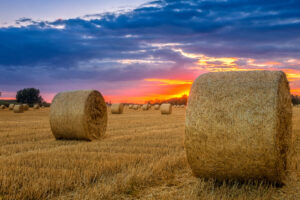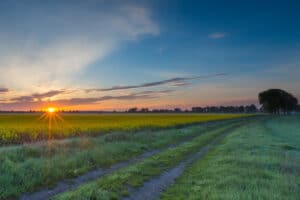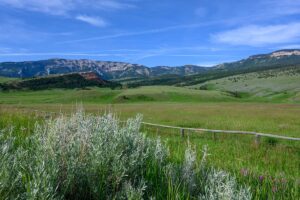The just-released U.S. Census of Agriculture reported a decline in farmland acres from about 938.3 million in 2002 to about 922.1 million in 2007, a loss of 1.7 percent.
My Sunday Richmond (VA) Times-Dispatch carried “Loss of farmland accelerates in Va.” above the front-page fold with a large color photo of an older Augusta County farmer trudging through his barnyard. He’s quoted as never having made as much as $20 an hour as a full-time farmer.
He, like many other farmers, is cash poor and land rich.
His 400 acres of pasture and cropland might bring $4,000 an acre if sold to a farmer for farming, but it would fetch at least two or three times that if sold to developer for housing. Developers can make more money selling an acre of housing once than farmers can selling an acre of corn over their lifetimes.
America is converting farmland to development because Americans want to live in low-density suburbs, farmers are willing to sell their land and the market values this acreage higher as housing than farming. If you’re ready to retire and you face a choice between selling your only asset — your farm — for $2 million or $6 million, what would you do?
In each of the five years between 2002 and 2007, we lost an average of about 3.2 million acres, mostly to development. That annual rate has not changed for more than 15 years. So what does the loss of farmland mean?
Less farm acreage does not appear to have translated into less food or higher food prices. Other factors — commodity prices, risk and technology– determine production.
Take Virginia. Of its 18 principal crops, from apples to winter wheat, only two — flue-cured tobacco and burley tobacco — showed production decline between 2007 and 2008 — and these were modest, according to an April 17, 2009 report from the USDA’s, National Agricultural Statistics Service. Despite losing more than 100,000 acres in 2008, Virginia farms produced more of its other 16 crops.
Embedded in the overall loss of U.S. farmland is a counter trend, namely that harvested cropland acres increased from 302.7 million acres to 309.6 million in the 2002-2007 period. Ethanol-based corn brought most of this “new” acreage into play.
We don’t know how much lost farmland is sold into development because the USDA’s Natural Resources Conservation Service did not have the funds to continue this tracking through its National Resources Inventory in recent years.
While high-quality farmland is being lost in places like California’s San Joaquin Valley, my sense is that much of the conversion around metropolitan areas is concentrated in uneconomic pasture, less productive cropland and marginal timberland. Our best farmland is not generally found on the fringes of many of our largest cities, with exceptions like Philadelphia and Washington, D.C. However, loss of “suburban farmland” does hinder farm-to-big-city marketing that emphasizes local production and freshness.
Long-term, of course, sustained farmland loss could impact agricultural production. At the extreme, were America to lose 3 million acres each year for the next 310 years, we will finally have no farmland at all. More likely is that agricultural technologies will continue to improve production efficiency and less land will be required to produce an increasing amount of output. And for consumers who don’t like technology-jiggered food, we now have 20,000 organic farms, a number that increases each year.
Farming advocates, like the American Farm Bureau, worry about farmland loss, even though the total number of farms is increasing as is the production of many products and their gross value.
Environmentalists rightly see the loss of close-in farmland, or open land, as the first step toward more suburban sprawl, which everyone agrees wastes energy, bears hidden economic costs and contributes to air, water and resource problems. Their issue is sprawl, not farmland loss.
No one argues on behalf of sprawl, which spreads because that’s what the market wants and supplies. Efforts to stop sprawl, reverse sprawl, control sprawl, reduce sprawl, manage sprawl and improve sprawl have done little to lower the rate of farmland loss.
Conservation of “suburban farmland” either through direct purchase or tax-favored restrictive easements has not been sufficiently extensive to be effective. It makes more sense to me to preserve suburban open space as parks of different types than as working farms.
Pockets of open space in sprawled suburbs have neither lowered the rate of farmland loss nor reduced sprawl. They simply squeeze development toward land that is for sale and increase the price of private lands that border these windfall amenities.
When I read the predictable loss-of-farmland stories, I start arguments with myself that go something like this:
First, America has lost farmland to development for the last 75 years, more or less in step with population growth. The U.S. Census Bureau projects a gain of another 110 million to about 419 million or so by 2050, which is about one-third more than our current population. If we, as a Nation, decide we don’t want sprawl and all its problems, should we not start encouraging ourselves to have no more than two children?
Each of our last three presidents has followed this guideline.
Every environmental problem America has — and most of our economic ones — will be easier and cheaper to solve if we slow population growth through family planning and reducing illegal immigration.
Second, the housing market produces sprawl because suburbs are profitable to develop and house buyers want to live out rather than in.
If we want to stop sprawl, we would have to forbid farmers from selling to developers, forbid developers from developing farmland or have public agencies buy it. The implications of such decisions would change who we are, where we live and how we act.
Third, it’s obvious that America needs enough farmland to feed itself, today and tomorrow. It’s not obvious how that number of acres — which moves in relation to population, exports, prices and technology — can or should be determined. Nor is it clear what we should do if we reach a point where it looks like we won’t have enough acreage for our needs and the market fails to value farmland high enough for continued farming.
And so we have one more ridiculously hard set of questions for the Obama Administration and everyone else to think about.
This content may not be used or reproduced in any manner whatsoever, in part or in whole, without written permission of LANDTHINK. Use of this content without permission is a violation of federal copyright law. The articles, posts, comments, opinions and information provided by LANDTHINK are for informational and research purposes only and DOES NOT substitute or coincide with the advice of an attorney, accountant, real estate broker or any other licensed real estate professional. LANDTHINK strongly advises visitors and readers to seek their own professional guidance and advice related to buying, investing in or selling real estate.









Those are some interesting questions Curtis. I read the Richmond Times article and thought that the writer left out some important points. In the past 100 years as our country has grown and become more industrialized, families have moved from farms to industrial jobs leaving behind farms of which many have become timberland. The population movement of folks from the south to the north for jobs and from the east to the west for jobs is well documented and every time leaving behind farms and small towns that are now timberland and the towns are deserted. I cant tell you how many times I have been on a large tract of timberland far removed from anywhere only to find home foundations of an old community. My point is while everyone wringing their hands over urban sprawl the recent economic downturn has successfully reduced development on its own, just call several of your local County planners to see how busy they are. The north east and northern middle states populations are trending to southern areas especially areas where there are jobs. I do not have any statistics to show but I will also point out that many rural communities are dying because of the lack of industries. Textile, furniture and other manufacturing companies have closed down in the past 15 yrs in Virginia. Those communities supported small businesses and farms. The plants have closed and the leaders of the communities, the Counties and the state have not attracted enough industry back to these communities.The communities die and the folks move to where the jobs are, leaving behind small farms that generally become timberland. There is some of your urban sprawl.
An interesting question is: Where should new economic activity be located? In the wrecked cities of the Rust Belt? In small towns that have been abandoned by earlier industries who have closed or moved? In suburbs?
Left to their own devices, investment usually follows the herd instinct–location on Interstates, not far from population centers of one size or another.
In an Internet age, many of the factors driving these location decisions are out of date in my opinion. Small towns can offer good locational advantages for small and medium-size
projects.
As to sprawl, I don’t think an unregulated market can stop/control it. Nor am I sure that a
regulated market can do much better given the politics and economics driving these decisions. I’m certainly willing to be persuaded otherwise.
Yrs.
Curtis
“The just-released U.S. Census of Agriculture reported a decline in farmland acres from about 938.3 million in 2002 to about 922.1 million in 2007, a loss of 0.017 percent.”
That’s 1.7%, actually, which is a much more significant number. It would be interesting to correlate economic boom and bust cycles with increases in residential and supporting real estate uses, particularly with respect to such loss of farmland. That way, you could “smooth out” the apparent recent spike in “gobbling up” farmland.
As always, thanks for a well-written, thought-provoking article, Curtis!
Jim is right on the percentage. Thanks for the correction. I miswrote the percentage.
He’s also right in suggesting that spikes usually can be made sense out of by figuring out how underlying factors smoothe them out over time.
My apologies to landthink readers for getting the number wrong.
Yrs. Curtis
Where are the 30+ million acres of CRP, etc counted.? That is about 9% of the farmland acres.
If CRP programs were discontinued and the idled land put into production…… its spelled – S-U-R-P-L-U-S . Go figuire .
Curtis, I read your article tonight that you wrote last May about lost farmland. I really am disturbed that we are losing our farmland and the many families that are the caretakers of our land in the USA. Instead of decreasing the amount of children people have, how about increasing the amount … farmers would then have large families to work the land instead of migrant workers. There are some countries that are concentrating on large families rather than small ones, and if that continues to happen, guess what… they may someday take over the good old USA and we won’t have anything! So, I say increase your families and save America!
C H Bullock, I agree about the larger families. I have always supported the ideas of large families raised in family farm life. I have come to realize the issues others are dealing with in other countries, and find poverty is what drives the migrants here into our country in the first place. As an Internet Marketer I deal with individuals all over the world. I seek ways in order to help others around the world to find Internet businesses so they will become self-sufficient. I like the idea of the organic farms coming up in place of the old ways that are unhealthy with the use of chemicals. Humans generally do not like change but with the way the environment has become we must make some major changes in order to save what is becoming extinct, and to save ourselves from the lack of food we are over sourcing. Change must come for the environment, for our health and the planet.
I Was Just Wondering, What Would you Estimate The Percent Of Land Lost In 2025?